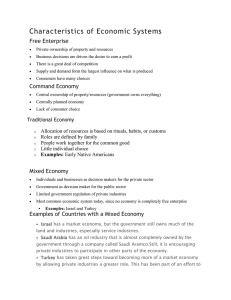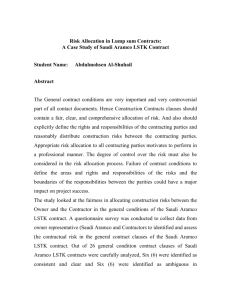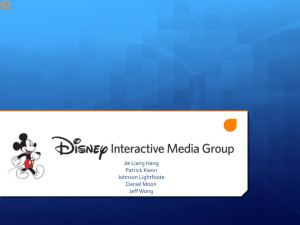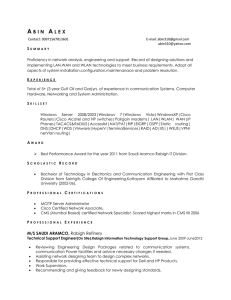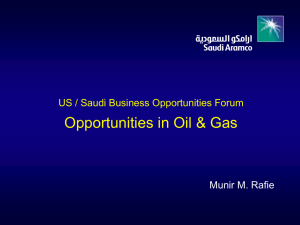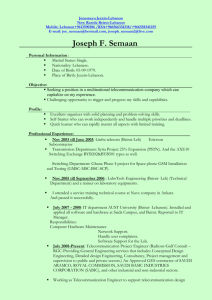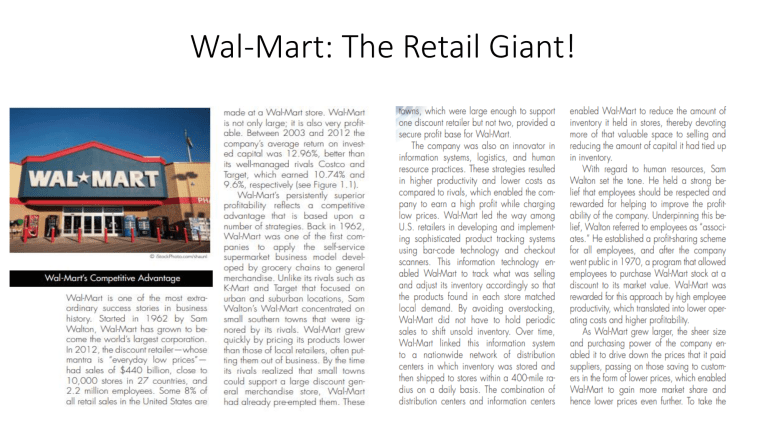
Wal-Mart: The Retail Giant! Wal-Mart: The Retail Giant! Key Facts • A management theme: everyday low prices • A giant that does not follow a diet: getting healthy by eating more. • self-service supermarket business model developed by grocery chains to general merchandise • K-Mart and Target urban and suburban • First mover advantage Will you be there?! • strategy • strategic leadership • strategy formulation • strategy implementation Strategic Leadership, Competitive Advantage, and Superior Performance Competitive Advantage and a Company’s Business Model • Competitive advantage: The achieved advantage over rivals when a company’s profitability is greater than the average profitability of firms in its industry. • Sustained competitive advantage: A company’s strategies enable it to maintain above-average profitability for a number of years. • Business model: The conception of how strategies should work together as a whole to enable the company to achieve competitive advantage. Industry Differences in Performance • Tough entry or it’s just easy to get into! • Excess capacity and price war or the other way around. Performance in Nonprofit Enterprises Yes! You are right. There are not doing business. But they do need money! The Leaders The Strategy-Making Process • 1. Select the corporate mission and major corporate goals. • 2. Analyze the organization’s external competitive environment to identify opportunities and threats. • 3. Analyze the organization’s internal operating environment to identify the organization’s strengths and weaknesses. • 4. Select strategies that build on the organization’s strengths and correct its weaknesses in order to take advantage of external opportunities and counter external threats. These strategies should be consistent with the mission and major goals of the organization. They should be congruent and constitute a viable business model. • 5. Implement the strategies The Mission, Vision, and Values • Vision: • The articulation of a company’s desired achievements or future state • Values: • A statement of how employees should conduct themselves and their business to help achieve the company mission. Starbucks values • With our partners, our coffee and our customers at our core, we live these values: • Creating a culture of warmth and belonging, where everyone is welcome. • Acting with courage, challenging the status quo and finding new ways to grow our company and each other. • Being present, connecting with transparency, dignity and respect. • Delivering our very best in all we do, holding ourselves accountable for results. • We are performance driven, through the lens of humanity. Major Goals • Precise and measurable • Key issues • Challenging but realistic • Time period Now, what goals should you pursue? Long or short it is.. External Analysis A Short Case of Saudi Aramco • Saudi Aramco, officially the Saudi Arabian Oil Company or simply Aramco, is a Saudi Arabian public petroleum and natural gas company based in Dhahran. As of 2020, it is one of the largest companies in the world by revenue. Given the opportunities of external opportunities in the form of population growth, urbanization, industrialization, growing interest in renewable energy and exposure to threats of competition from other oil and gas companies, environmental regulations and increasing pressure to reduce carbon emissions Saudi Aramco has implemented several strategies. For example, the company is investing heavily in renewable energy technologies and diversifying its energy portfolio. It has also expanded its operations globally, established joint ventures and partnerships with other companies, and invested in research and development to enhance efficiency and sustainability. Additionally, Saudi Aramco has implemented initiatives to reduce its carbon footprint and comply with environmental regulations. By considering the external opportunities and threats, Saudi Aramco is able to develop a strategic plan that leverages the opportunities and mitigates the threats to ensure its long-term sustainability and profitability in a highly dynamic and competitive market. Internal Analysis A Short Case of Walt Disney (WD) • Walt Disney is one of the most recognized and trusted brands in the entertainment industry. Its internal strength ranges from diversified business portfolio such as media networks (ABC, ESPN, Disney Channel, Freeform, and National Geographic), theme parks (Disneyland and Disney World in the United States, Tokyo Disney Resort, Disneyland Paris, and Shanghai Disney Resort), movie studios (Walt Disney Pictures, Pixar Animation Studios, Marvel Studios, Lucasfilm, and 20th Century Studios), and consumer products (toys, clothing, accessories, home decor, and digital media). Given the competition of the entertainment and the diversification motives of WD have explored the WD’s business model. However, high profit levels and creative teams make WD talk above the crowd. • Although WD has diversified product lines it has a heavy reliance on its key franchises, such as Marvel, Star Wars, and Pixar, High production costs, reliance on single market, huge HR base. Follow it or I will look it up • Strategic implementation (here comes the decision from top) • Feedback loop (here comes the feedback from bottom and action from top) • Tesla : Tesla receives feedback from its customers through various channels, including social media, online reviews, and customer surveys. This feedback can include suggestions for new features, complaints about existing features, and ideas for improving the overall customer experience. Strategy as an Emergent Process • Strategy Making in an Unpredictable World • Autonomous Action: If you want you can do it! Break the status quo of top managers. Example: Netflix, Zappos, Southwest Airlines. Starbucks’s Music Business Strategy as an Emergent Process • Serendipity and Strategy Play-Doh (Hasbro): Play-Doh was originally developed as a wallpaper cleaner, but it was later discovered that children were using it to create art projects. Hasbro recognized the potential of Play-Doh as a children's toy and began marketing it as such. Penicillin (Fleming and Pfizer): Penicillin was discovered by Alexander Fleming in 1928 when he noticed that mold had contaminated one of his petri dishes and was preventing the growth of bacteria. Fleming recognized the potential of this discovery and began to study the mold, leading to the development of penicillin as an antibiotic. Later, Pfizer recognized the value of penicillin and became the first company to mass-produce it, leading to a revolution in medicine and the treatment of bacterial infections. Microwave ovens (Raytheon): Microwave ovens were discovered by accident in 1945 by Percy Spencer, an engineer at Raytheon, when he noticed that a candy bar in his pocket had melted while he was working on a radar system. Spencer recognized the potential of this discovery and began to experiment with cooking food using microwave radiation. This led to the development of the first microwave oven in 1947 and the subsequent revolution in home cooking and convenience foods. Velcro (de Mestral): Velcro was discovered by George de Mestral in 1948 when he noticed how burrs from a plant stuck to his clothing and his dog's fur. De Mestral recognized the potential of this discovery and began to study the mechanism by which the burrs stuck to fabric, leading to the development of Velcro as a fastener. Intended and Emergent Strategies Honda’s business in USA 250-cc and 350-cc machines vs 50-cc. Strategic Planning in Practice • Scenario Planning • Decentralized Planning Strategic Decision Making • Cognitive Biases and Strategic Decision Making • Prior hypothesis bias • Escalating commitment • Reasoning by analogy • Representativeness • Illusion of control • Availability error • Techniques for Improving Decision Making • Devil’s advocacy • Dialectic inquiry • outside view Strategic Leadership • Vision, Eloquence, and Consistency • Articulation of the Business Model (Michael Dell, Sam Walton) • Commitment (Nucor’s former CEO Ken Iverson) • Being Well Informed (former Starbucks’s CEO Jim Donald, Herb Kelleher, the founder of Southwest Airlines) • Willingness to Delegate and Empower • The Astute Use of Power • Emotional Intelligence
